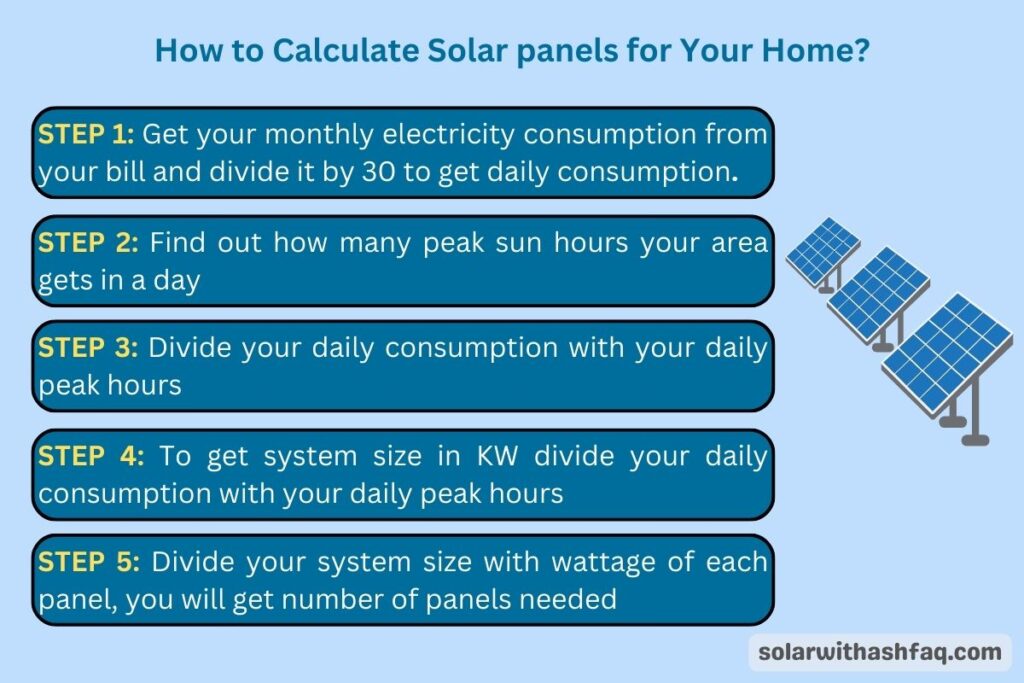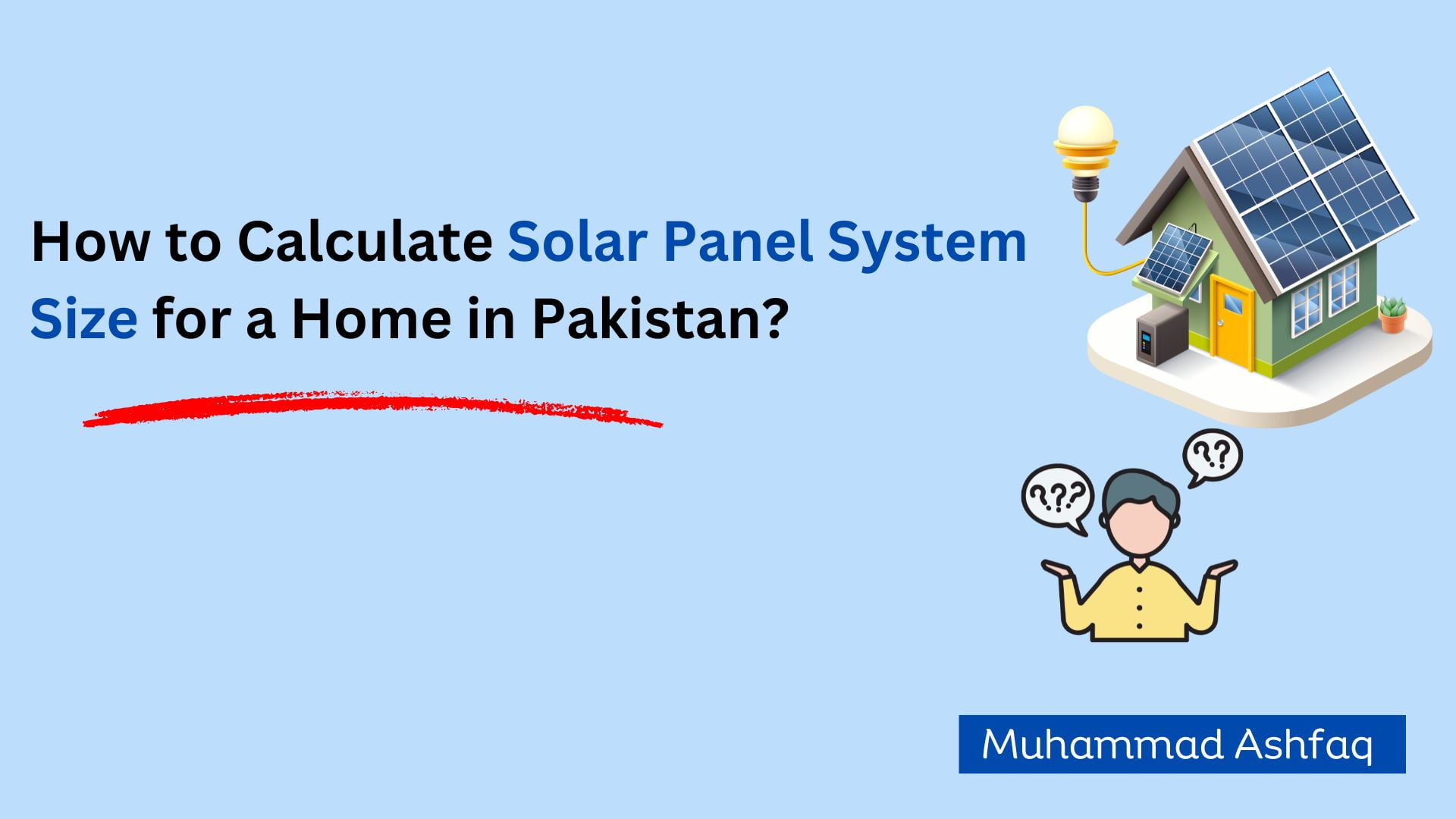How to Calculate Solar Panel System Size for a Home in Pakistan?
When we think about installing solar panels in our homes, the first question that comes to our mind is what should be the size of our solar panel system?
Often, due to a lack of professional knowledge, we rely on installer companies to guide us.
While it’s not always the case that they will install more than we need, but it’s important to remember that solar companies are doing business (and of course, profit is their focus). Therefore, it’s beneficial for us to understand how to calculate the appropriate size of a solar system for our home.
A typical home in Pakistan needs around 6-10 solar panels to sufficiently cover its power needs. This article provides a step-by-step guide to calculating the optimal solar system size for your home.
So, without further ado, let’s get to the business:
Factors That Determine the Size of Your Home Solar System
For your home, you know your energy needs best. While online calculators and solar vendors can provide estimates, the most accurate way to determine how many solar panels you need is to assess your energy consumption.
It’s not rocket science, but there are a few factors to consider when sizing your home solar system. For that, you just need your past electricity bill in your hand to get things started. From that, we will calculate:
- Your monthly electricity usage
- How much sunlight your home gets
- The wattage of the solar panel
Now, let’s dig into simple math steps to make things happen.
Steps to calculate how many solar panels do you need?
Step 1: Find out how much electricity you use
First, take a look at your past electricity bills. Check the “total kWh used” or “total units” from the last 12 months. This will give you a good sense of your annual electricity usage.
Next, focus on your peak usage months—maybe June, July, and September when you’re running the AC more. Take the average of those three months to get a better idea of your typical monthly electricity needs.
For example, let’s say your average monthly consumption is 400 kWh per month (kWh stands for kilowatt-hours, which is the standard unit for measuring electricity usage). To calculate your average daily usage, you divide 400 by 30 days, which comes out to about 13 kWh per day.
Average daily use = 13 units
Step 2: How many peak sun hours your home gets?
Determining how many peak sun hours (which are different from daylight hours) your home gets is an important step in deciding a solar system’s size.
Peak sun hours refer to a period when the sun’s rays are most powerful in a given area, with an average intensity of 1,000 watts of power per square meter (W/m²).
The more peak sun hours your home receives, the more electricity your solar panels can generate. And that means more significant savings on your electric bills.
The number of peak sun hours can vary depending on your location, weather patterns, and the time of year. Generally, homes in Pakistan receive around 5-7 peak sun hours per day, but this can fluctuate.
Let’s take Rawalpindi as an example; the average peak sun hours here are around 5.5 hours per day.
Peak sun hours = 5.5 hours/day
Step 3: Determine the solar panel system size you need
To calculate the solar panel system size you need, simply divide your daily electricity consumption by the average sun hours.
Solar System size = daily electricity consumption / average sun hours
In this case, 13 units divided by 5.5 sun hours comes out to approximately 2.36 kilowatts (kW). This means you’ll likely need a 2.36 kW solar panel system to meet your home’s energy needs.
Keep in mind that this is an ideal system size, and the actual system size may vary depending on the factors discussed below.
Step 4: Accommodating the Production ratio of panels
The production ratio, also known as the performance ratio, compares the actual output of your solar system to the output it would produce under ideal conditions. This ratio takes into account real-world factors that can reduce output, such as
- Dust
- Shade
- Panel aging
- Temperature
- And inverter inefficiencies.
Knowing your production ratio is critical because it gives you a realistic expectation of your system’s production.
As a rule of thumb, all the above factors decrease the panel’s overall production by 20%, meaning our actual production would be 80%.
To accommodate your production ratio, simply divide your system size by 80% (that is 0.8).
Your ideal system size (calculated above) is 2.36 kw; dividing it by 0.8 comes out to be 2.95 kw (approx. 3kw)
Actual system size = Ideal system size / 0.8
Actual System size = 3kw
Step 5: Calculate how many solar panels you need
Now, onto the final step—the number of solar panels needed. For that, we need to select the size of a single panel.
First, look at some standard solar panel wattages. Reputable brands like Longi, Jinko, and Canadian Solar offer 500-585 watt solar panels. For simplicity, we’ll use the Longi Hi-Mo 500 watt panel as an example.
We’ve calculated above our solar system size, which is 3 kW. To calculate the number of panels you need, we divide the total system size (3 kW) by the wattage of a single panel (500 watts).
Number of panels = system size in Watts/wattage of single panel
Number of panels = 3000 W / 500 W
Number of panels = 6

Estimate your system size and cost with our solar calculator.
What Should be the Size of the Inverter?
Selecting the right size of the inverter is crucial for the best performance of your solar system. You should always choose an inverter slightly larger than your solar system’s size.
There are several reasons why oversizing the inverter is recommended:
- Peak Power Output: A larger inverter can handle the peak power output during high solar irradiation, leading to higher energy production from your system.
- Energy Storage: Bigger inverters can support energy storage systems (batteries), allowing you to store excess energy generated during peak sun hours.
- System Efficiency: Larger inverters can optimize your solar system’s overall efficiency by minimizing power clipping (also known as inverter saturation, which occurs when the DC power from the panel exceeds the inverter’s maximum input level) and ensuring the system operates at or near its maximum capacity.
- Future System Expansions: Choosing an inverter larger than your current solar system size gives you the flexibility to expand your system in the future without needing to replace the inverter.
The recommended inverter size for a 3kW solar system in Pakistan is typically around 3-4kW. The most popular solar inverter brands in Pakistan, such as Inverex, Growatt, Solis, Solarmax, and Huawei, offer inverters with an efficiency of around 97-98%.
In our case, we’ll use a 4kW Inverex inverter. This will provide you with the headroom to accommodate peak power output, support any future energy storage needs, and optimize the overall efficiency of your solar system.
What Appliances Can be Used on a 3kw Solar System?
When it comes to powering your home with a 3kW solar system, it’s important to understand the wattage requirements of Pakistan’s most commonly used appliances. This will help you determine which devices you can comfortably run on your solar setup.
Let’s take a look at some of the key appliances and their typical wattage needs:
[ninja_tables id=”2926″]First, let’s talk about the basics. A 3kW solar system in Pakistan can typically generate around 12-13 kWh of electricity per day. This is generally sufficient to meet the needs of a small household, but the exact number and type of appliances you can run will depend on their power consumption.
Here’s a quick rundown of what you can expect to power with a 3kW system:
- 3 fans
- 7 lights
- 1 LED TV
- 1 refrigerator
- 1 washing machine
The good news is that you can easily power above load (lights, fans, television, refrigerator, and laptop) all at the same time on a 3kW system. These are typically lower-power devices that won’t overload your solar setup.
I know what you might be thinking – what about other common household appliances like an iron, water pump, or air conditioner?
Well, those can work, too, but you’ll need to be a bit more careful.
These power-hungry appliances have motors (in the case of AC and water pumps) that draw a lot of current, especially when starting up. This startup current can be 3-5 times higher than the normal running current, so your 3kW system could become overloaded, causing your electrical protections to trip.
Solar Tip
To run the AC or water pump, use them one at a time with the other load of your home switched OFF. A 3kw setup can easily power these devices during peak sun hours.
Can Solar Panels Power Your Entire House?
The short answer is that solar panels can meet the full electricity needs of most homes in Pakistan, but the exact system size will depend on your unique energy profile and the nature of your home load.
One key factor is that solar panels don’t produce electricity at night, so you’ll need batteries to store excess energy generated during the day to use at night. This means your solar system size will need to be larger to cover both your daytime usage and the extra energy required to charge the batteries.
To give you a rough idea, most homes in Pakistan can meet their full electricity needs with a solar panel system ranging from 5 to 10 kilowatts in size. However, the right system size for your home will depend on factors like your average daily energy consumption, the size and orientation of your roof, and the net metering program.

Wrapping Up
Following the step-by-step process outlined in this guide, you can accurately calculate the solar system size needed to meet your energy needs, whether that’s a 3kW system capable of running common household appliances or a larger 5-10kW system that can fully offset a home’s electricity consumption.
With the right solar setup, homeowners in Pakistan can take control of their energy costs and reduce their carbon footprint.
Frequently Asked Questions
To size your solar system for your house in Pakistan, calculate your average daily electricity consumption in kWh and then divide it by peak sun hours. For an average monthly consumption of 400 units, a 3kW solar system is recommended.
The number of solar panels required to run a house in Pakistan depends on several factors, including the solar system’s size, the solar panels’ wattage, and the household’s energy consumption. Typically, a 3kW solar system can power a small to medium-sized home in Pakistan, which requires around 6-8 solar panels of 500W each.
The cost of a 3kW solar system in Pakistan varies depending on the brand, quality, and type of solar panels and inverters used. On average, a 3kW solar system in Pakistan can cost between Rs. 350,000 to Rs. 600,000, including installation charges.
A 3kW solar system can power one air conditioner (AC) at a time, depending on the AC’s wattage. For example, a 1.5-ton AC typically consumes around 1.5 kW of power. Therefore, a 3kW solar system can run one 1.5-ton AC (without any other load connected).
To determine the number of solar panels required for a 1.5-ton AC, you need to calculate its total energy consumption in kWh. Assuming the AC consumes around 1.5 kW of power, you would need a solar system capable of producing at least 1.5 kWh of electricity per hour. Based on this calculation, you would require around 6-7 solar panels of 500W each to power a 1.5-ton AC.

Content Writer | Assistant Manager (Electrical) at IESCO
As a passionate content writer, I’m on a mission to make solar hassle-free for you through my expert guides and easy-to-digest content.

